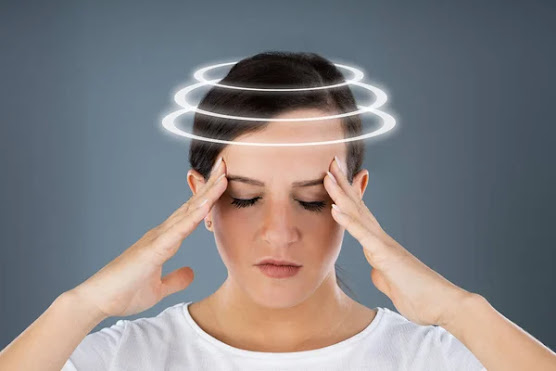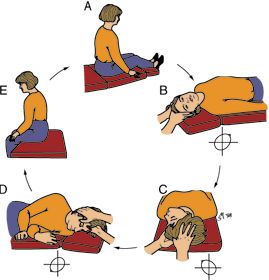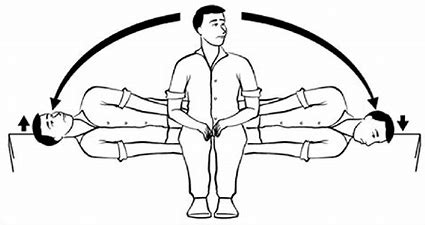The Best Home Remedy And Exercises For Vertigo or Dizziness
Note: Friends, if you are comfortable in reading this article in any other language, please change the language from the translate button on the top of this article.
 |
| Vertigo, often known as the feeling of spinning and dizziness, can limit one's activities and make one feel ill |
Image: dreamstime
Overview
Vertigo, often known as the feeling of spinning and dizziness, can limit one's activities and make one feel ill. It is a spinning and queasy sensation that can happen with or without movement.
The body is not out of balance but the brain believes it is.
To lessen the possibility of getting wounded if you fall, you should sit down as soon as you begin to feel dizzy. Also when you go to the washroom, sit on the commode for passing urine (for men)
Vertigo typically manifests as a symptom of one or more underlying medical disorders. Vertigo can sometimes only happen once, but for some people, it will keep happening until the underlying cause is identified.
Causes of Vertigo or Dizziness
An issue with the inner ear frequently results in vertigo. Among the most frequent causes are:
BPPV (benign paroxysmal positional vertigo)- The cause of BPPV is the accumulation of microscopic calcium ions (canaliths) in the inner ear after they become displaced from their usual site.
The brain receives messages from the inner ear regarding how the head and body are moving in relation to gravity. It aids in maintaining balance.
BPPV can happen for unknown reasons and could be influenced by aging.
Meniere's Disease- An accumulation of fluid and shifting pressure in the ear is thought to be the causes of this inner ear condition. Hearing loss, tinnitus, and episodes of vertigo are all possible side effects.
Labyrinthitis or vestibular neuritis-An infection is typically the cause of this inner ear issue (usually viral). Infected nerves near the inner ear's balance-supporting nerves become inflamed as a result of the infection.
Vertigo or dizziness may also be caused by stretch in neck due to continuous wrong posture of the head.
It generally happens when we fall asleep while reading a book or watching mobile at night. In this case, we generally feel dizziness when we get up in the morning.
While there are medications for vertigo, they are not always necessary, especially when there are non-drug alternatives that work just as well.
Here we shall discuss an amazing home remedy for Vertigo. I also used and benefited from this remedy once when I experience Vertigo.
Amazing Home Remedy for Vertigo, Dizziness, or Giddiness:
Please see the above video for reference.
. Take 2 teaspoons of Gooseberry Powder (Amla Powder) at night.
. Mix this to a glass of water.
. Also, mix to it 2 teaspoons of Coriander Powder and a slice of Ginger.
. Cover and let it soak for six to eight hours.
. In the morning mix to it 2 teaspoons of Rock Sugar.
. Drink it for 7 to 10 days.
. It will give relief in 4 days, still, take it.
. It is also good for migraine, headaches, mental weakness, and eye strain.
In addition to the above remedy, you may also try the following popular exercises and precautions:
1.Epley Maneuver
 |
| The Epley maneuver, often known as the "Canalith" repositioning maneuver, is the first method that many vertigo sufferers turn to |
The Epley maneuver, often known as the "Canalith" repositioning maneuver, is the first method that many vertigo sufferers turn to. For those with BPPV, the Epley maneuver works wonders. Simply follow these steps to perform the technique at home:
A. Start by assuming an upright position on a flat surface, placing a pillow behind you, and extending your legs. Turn your head 45-degree to the right
B. Quickly lean back with your head on the pillow while keeping your head tilted. Spend at least 30 seconds in this position.
C. Without elevating your neck, slowly tilt your head 90 degrees to the left.
D. Turn your entire body to the left, engaging it, until you are entirely lying on your left side.
E. Slowly take a seat upright and face forward as you return to your starting posture.
You could also ask someone to help you perform the Epley technique by guiding your head in the manner described above. You can do it three times in a row and each time you can feel lightheaded.
2. Semont-Toupet maneuver
 |
| You can treat vertigo at home with combination of movements known as the Semont-Toupet maneuver |
Image: ResearchGate
You can treat vertigo at home with a similar combination of movements known as the Semont-Toupet maneuver. Although this technique is less well-known it works just as well.
Although the Semont-Toupet maneuver demands less neck flexibility than the Epley Maneuver, they are remarkably comparable.
1. Start by assuming an upright position on a flat surface, placing a pillow behind you, and extending your legs.
2. When lying down, turn to your right and look upward while looking to your left side.
3. Quickly sit up and turn to your left side while maintaining a left-facing stance. Now your gaze will be directed toward the ground.
4. Slowly take a seat upright and face forward as you return to your starting posture.
3. Brandt-Daroff Exercises
 |
| You can treat vertigo at home with |
the Brandt-Daroff exercises
Image: ResearchGate
You can treat vertigo at home with a similar combination of movements known as the Semont-Toupet procedure. Although this tactic is less well-known, some research Trusted Sources contend that it is equally effective.
The Brandt-Daroff exercise may induce heightened dizziness for a brief period of time, therefore you shouldn't practice it unless you are in a secure location and won't be driving for a while.
1. Start by assuming the position of a chair, with your legs hanging loosely from it.
2. Lay your head and torso down on your right side after turning your head as far to the left as you can. You shouldn't move your legs. Spend at least 30 seconds here.
3. Reposition your head back in the center place as you stand up.
4. Turn your head as far to the right as you can, then lie down on your left side to repeat the exercise on the other side.
This exercise can be performed in a set of five repetitions and up to three times per day, twice per week.
4. Keep Hydrated
Simple dehydration can occasionally produce dizziness. Taking less sodium may be beneficial. But just drinking lots of water is the greatest method to keep hydrated.
Keep an eye on your water intake and make an effort to plan for hot, humid weather and sweaty circumstances that could cause you to lose more fluids.
When you are prone to dehydration, make a plan to drink more water. You could discover that merely being conscious of how much water you're consuming will help lessen episodes of vertigo.
5. Take Vitamin D
You might be correct if you think a deficiency in your diet is the cause of your vertigo. For those who suffer BPPV, the most frequent type of vertigo, a lack of vitamin D can make their symptoms worse.
You can increase your vitamin D levels by drinking fortified milk or orange juice, eating canned tuna, or even eating egg yolks.
In order to determine if you require a supplement or extra vitamin D in your diet, have your doctor examine your vitamin D levels.
6. Avoid Alcohol
According to the Vestibular Disorders Association, alcohol can really alter the makeup of the fluid in your inner ear in addition to making you feel woozy. Also, alcohol is dehydrating.
Even when you are sober, these factors might impair your equilibrium. You can get relief from your vertigo symptoms by reducing or perhaps quitting your alcohol use.
Questions People Ask About Vertigo:
Our Other Must-Read Articles:
Q. Does vertigo ever go by itself?
A. It's possible for your vertigo to go away without any specific treatment. For instance, BPPV sufferers frequently discover that their symptoms go away after a few weeks or months.
Your doctor can advise you on whether or not your problem requires treatment.
Q. What is the best exercise for vertigo?
A. Exercises for vertigo include
Brandt-Daroff
The Epley Maneuver
& The Semont-Toupet Maneuver,
the steps for which are described in the article's section above.
Q. What causes Vertigo and who is at risk for it?
A. Even when someone is at rest, vertigo causes them to feel as though they are spinning or swaying. An issue with the inner ear, the brain, the spinal cord, or both may contribute to vertigo.
It May also be due to traumas to the head, neck stretches brought on by incorrect head posture, and some drugs. Higher vertigo risk is related to the female gender.
Q. What are the things that trigger vertigo?
A. If you are experiencing vertigo then avoid these foods:
Salty foods-Your diet is probably rich in salt if it includes a lot of processed foods.
Sugar-rich foods-High-sugar foods will also throw off your fluid balance, which could make you dizzy.
Foods that cause migraines-Tyramine, an amino acid, has the ability to cause migraines.
Alcohol and coffee.
Q. Is vertigo a serious condition?
A. Although annoying, vertigo is rarely an indication of a serious medical condition.
In order to alleviate the symptoms of vertigo, treatment must address the underlying condition that is causing the dizzying sensations.
Your doctor may also only treat the vertigo symptoms if there is no recognized reason.
Q. Is vertigo a symptom of a brain tumor?
A. No, vertigo is not an indication of a brain tumor. it is related to inner ear problems.
Q. Does anxiety cause vertigo?
A. These impacts may be felt if you're stressed, anxious, or depressed.
These feelings have the ability to both independently create vertigo as well as to exacerbate the symptoms of an underlying illness, such as an inner ear disorder.
Q. Is vertigo caused by dehydration?
A. Dehydration might make you feel lightheaded. You might also feel woozy, lightheaded, unsteady, and dizzy when you get this sensation.
Vertigo is a particularly specific type of dizziness that you could potentially experience.
Q. Can ear wax cause vertigo?
A. If the earwax rubs up on the tympanic membrane, which is the eardrum, vertigo may also result.
This symptom can make a person feel queasy and as though they are moving even when they are not.
Q. Does drinking water help in vertigo?
A. Keeping hydrated can significantly reduce the symptoms of vertigo. In order to prevent dehydration and vertigo, make sure to consume at least eight glasses of water each day.
Q. Does lack of sleep cause vertigo?
A. Numerous aspects of waking life can be hampered by poor sleep. In fact, a 2017 study was published in
The Laryngoscope discovered that people with sleep apnea had a considerably greater prevalence of daytime vertigo.
Q. Can you drive with vertigo?
A. Your ability to drive could be impacted by vertigo.
If you've recently experienced vertigo episodes and there's a danger you might experience another one while driving, you should refrain from operating a motor vehicle.
Q. How long does vertigo usually last?
A. The symptoms of vertigo will change based on the type.
Vertigo symptoms for Meniere's disease can last anywhere from 20 minutes to 24 hours. In contrast, BPPV symptoms can persist for a week or longer.
Q. Can cleaning your ears with Q-tips cause vertigo?
A. Yes, if you push it too far, it may lodge wax against the eardrum.
If you continue to push, it may perforate the eardrum, harm the hearing bones, and even injure the inner ear. Vertigo and hearing loss are possible side effects of this.
Q. Does bed rest help vertigo?
A. Avoid bed rest and return to your normal activities as soon as you can, according to medical guidance for vestibular neuritis.
In order to prevent vertigo from becoming a chronic issue, your activities force the brain to begin adjusting to it.
Q. What should you not do when you are having vertigo?
A. If you begin to feel dizzy, sit or lay down right away. If you have a severe case of vertigo, lie still with your eyes closed in a dimly lit area.
If you frequently feel dizzy without notice, refrain from operating machinery or driving a car. Steer clear of salt, alcohol, caffeine and smoke.
Q. How do I clean my inner ear?
A. Employ warm water. When the wax has melted after a day or two, gently pump warm water into your ear canal using a rubber-bulb syringe.
To straighten your ear canal, tilt your head back and pull your outer ear up and back. Tip your head to the side to allow the water to drain after you have finished irrigating.
Friends, if you like the article, share it with your friends. Any of them may be in need of this.
Moreover, if you know of any other good remedy for this or if you have any suggestions, please feel free to write a message. We shall highly appreciate it.
Stay Fit, Stay Happy
______________________________
Friends, if you liked it, please share and let it reach your friends.
SHARING IS CARING.
Compiled by: Paramjit Singh Rana

Comments
Post a Comment